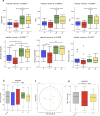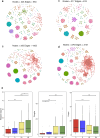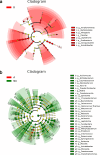Exploration of the Changes in Facial Microbiota of Maskne Patients and Healthy Controls Before and After Wearing Masks Using 16 S rRNA Analysis
- PMID: 38771488
- PMCID: PMC11442795
- DOI: 10.1007/s44197-024-00240-6
Exploration of the Changes in Facial Microbiota of Maskne Patients and Healthy Controls Before and After Wearing Masks Using 16 S rRNA Analysis
Abstract
Whether in the field of medical care, or in people's daily life and health protection, the importance of masks has been paid more and more attention. Acne, the most common complication after wearing masks, which is also called maskne, has been successfully introduced into the common language as a common topic of dermatologist consultations. This study aims to study the changes of microflora in maskne patients and healthy controls before and after wearing masks. In the summer of 2023, we collected a total of 50 samples from 15 maskne patients and 10 healthy controls before and after wearing surgical masks for a long time. 16 S ribosomal DNA sequencing and identification technology with V3-V4 variable region were adopted to explore the microbiome changes caused by mask wearing, analyze the changes in microbial diversity, and make interaction network. LDA effect size analysis was used to identify which bacteria showed significant changes in their relative abundance from phylum to genus. After wearing a mask, the microbiome of the maskne patients changed significantly more than that of the healthy controls, with both α diversity and β diversity lower than those of maskne patients before wearing masks and those of healthy controls after wearing masks. Co-occurrence network analysis showed that compared with other groups, the network of maskne patients after wearing masks for a long time had the lowest connectivity and complexity, but the highest clustering property, while the opposite was true for healthy controls. Many microbes that are potentially beneficial to the skin decreased significantly after wearing a mask. There was almost no difference in healthy controls before and after wearing a mask.
Keywords: 16s rRNA; Acne; Mask; Maskne; Microbiota; Skin.
© 2024. The Author(s).
Conflict of interest statement
The authors declare no competing interests.
Figures




Similar articles
-
Maskne: A side effect of wearing face mask and face mask-wearing attitudes and behavior during 1st, 2nd and 3rd waves of COVID-19 in rural population of Haryana.J Family Med Prim Care. 2022 Sep;11(9):5588-5592. doi: 10.4103/jfmpc.jfmpc_378_22. Epub 2022 Oct 14. J Family Med Prim Care. 2022. PMID: 36505531 Free PMC article.
-
Maskne: A New Entity in the COVID-19 Pandemic.Acta Dermatovenerol Croat. 2021 Dec;29(3):148-153. Acta Dermatovenerol Croat. 2021. PMID: 34990343 Review.
-
An epidemiological study on face masks and acne in a Nigerian population.PLoS One. 2022 May 19;17(5):e0268224. doi: 10.1371/journal.pone.0268224. eCollection 2022. PLoS One. 2022. PMID: 35588427 Free PMC article.
-
Effects of Mask Reuse on the Oropharyngeal, Skin, and Mask Microbiome.J Infect Dis. 2023 Aug 16;228(4):479-486. doi: 10.1093/infdis/jiad167. J Infect Dis. 2023. PMID: 37217829 Free PMC article. Clinical Trial.
-
The "Maskne" microbiome - pathophysiology and therapeutics.Int J Dermatol. 2021 Jul;60(7):799-809. doi: 10.1111/ijd.15425. Epub 2021 Feb 12. Int J Dermatol. 2021. PMID: 33576511 Free PMC article. Review.
References
-
- Hay RJ, Johns NE, Williams HC, Bolliger IW, Dellavalle RP, Margolis DJ, et al. The global burden of skin disease in 2010: an analysis of the prevalence and impact of skin conditions. J Invest Dermatol. 2014;134:1527–34. 10.1038/jid.2013.446. - PubMed
-
- White GM. Recent findings in the epidemiologic evidence, classification, and subtypes of acne vulgaris. J Am Acad Dermatol. 1998;39:S34–7. 10.1016/s0190-9622(98)70442-6. - PubMed
-
- Lichtenberger R, Simpson MA, Smith C, Barker J, Navarini AA. Genetic architecture of acne vulgaris. J Eur Acad Dermatol Venereol. 2017;31:1978–90. 10.1111/jdv.14385. - PubMed
-
- Williams HC, Dellavalle RP, Garner S. Acne Vulgaris. Lancet. 2012;379:361–72. 10.1016/s0140-6736(11)60321-8. - PubMed
MeSH terms
Substances
Grants and funding
LinkOut - more resources
Full Text Sources

